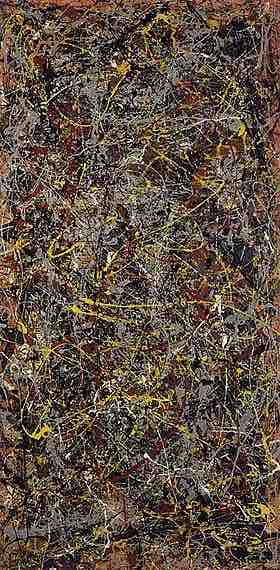The New York School was an informal group of American poets, painters, dancers, and musicians active in the 1950s and 1960s in New York City. It represented, and is often synonymous with, the art movement of Abstract Expressionism, such as the work of Jackson Pollack and Willem de Kooning. The artists of the New York School drew inspiration from surrealism and other contemporary avant-garde art movements, in particular action painting, abstract expressionism, Jazz, improvisational theatre, experimental music, and the interaction of friends in the New York City art world's vanguard circle.

No. 5, 1948
Jackson Pollack is known for his techniques in action painting, a style of abstract expressionism in which paint is spontaneously dribbled, splashed or smeared onto the canvas, rather than being carefully applied.

Willem de Kooning, Woman V, 1952-53
Willem de Koonig was an influential abstract expressionist painter.
Abstract Expressionism
A school of painting that flourished after World War II until the early 1960s, Abstract Expressionism is characterized by the view that art is non-representational and chiefly improvisational. Abstract Expressionist paintings share certain characteristics, including the use of large canvases, and an "all-over" approach whereby the whole canvas is treated with equal importance (as opposed to the center being of more interest than the edges). The canvas as the arena became a credo of Action painting, while the integrity of the picture plane became a credo of the Color Field painters.
The post-World War II era benefited some of the artists who were recognized early on by art critics. Some artists from New York, such as Norman Bluhm and Sam Francis, took advantage of the GI Bill and left for Europe, to return later with acclaim. Many artists from all across the U.S. arrived in New York City to seek recognition, and by the end of the decade the list of artists associated with the New York School had greatly increased. Painters, sculptors, and printmakers created art that was termed Action painting, Fluxus, Color Field painting, Hard-edge painting, Pop art, Minimal Art and Lyrical Abstraction, among other styles and movements associated with abstract expressionism.
9th Street Art Exhibition
The 9th Street Art Exhibition, otherwise known as the 9th St. Show or Ninth Street Show was held on May 21-June 10, 1951. It was a historical, ground-breaking exhibition, gathering of a number of notable artists, and it was the stepping-out of the post war New York avant-garde, collectively known as the New York School. The show was hung by Leo Castelli, as he was liked by most of the artists and thought of as someone who would hang the exhibition without favoritism. The opening of the show was a great success. According to the critic, historian, and curator Bruce Altshuler, "It appeared as though a line had been crossed, a step into a larger art world whose future was bright with possibility."
Interdisciplinarity in the New York School
In addition to painting, the New York School was associated with many poets, dancers, composers, jazz musicians, and writers. Poets drew on inspiration from Surrealism and the contemporary avant-garde art movements, in particular the Action painting of their friends in the New York City art world like Jackson Pollock and Willem de Kooning. In the 1960s, the work of the avant-garde Minimalist composers La Monte Young, Philip Glass, Tony Conrad, Steve Reich, and Terry Riley became prominent in the New York art world. The new Bebop and cool jazz musicians in the 1940s and 1950s (such as Charlie Parker, Miles Davis, John Coltrane, and Gerry Mulligan) coincided with the New York School and abstract expressionism. There are also commonalities between the New York School and the members of the beat generation poets active in 1940s, 1950s, and 1960s New York City, including Allen Ginsberg, Jack Kerouac, William S. Burroughs, Diane Wakoski, and several others.